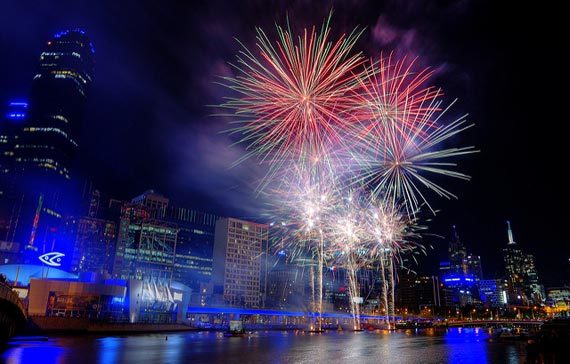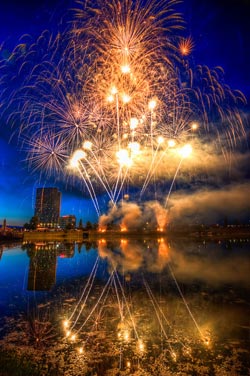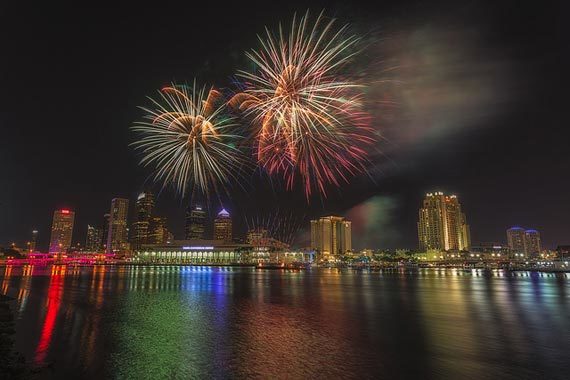Fireworks are the visual rulers of the nighttime universe. No matter how many times we see and experience their bombastic splendor, we always return to see what new designs will be exploded into the darkened sky.

Photo by Chris Phutully; ISO 100, f/6.3, 4-second exposure.
Watching fireworks is easy. Taking fantastic fireworks photos is not. Although photographing these light shows is more challenging than capturing a daylight portrait of Uncle Ben, it is not impossible. By following these four fireworks guidelines, you will take years off your learning curve and come away with fantastic fireworks photos.
There are four main categories of guidelines to understand in order to take fireworks photos that aren’t all black or out of focus:
1. Equipment
In addition to the standard equipment list, including batteries, memory cards, camera bag, etc., here is a shortened list of critical fireworks-specific equipment to bring along:
- Tripod — Realize that unless you use a tripod, you will most likely NOT like your fireworks photos.
- External shutter release (a.k.a. a “cable release”)
- Tiny flashlight so you won’t be fumbling around in the dark trying to move camera controls
- Chair that is easy to get in and out of
For best results, your camera should be able to focus manually, and you should be able to set desired shutter speeds of up to 15 seconds, or bulb. If you have never taken a picture with your camera other than in the automatic setting, it’s time to review your owner’s manual and determine your camera’s maximum shutter speed.
2. Location
Choosing the optimal location is a little bit harder than deciding how you can squeeze into a piece of 2 foot x 3-foot real estate on the lawn.

Photo by Miroslav Petrasko.
- Look for the optimum vantage point. Avoid sitting in an area with obstructions, such as streetlights, overhead wires, or trees.
- Decide if you want to capture additional elements (such as reflections off bodies of water or landmarks), and if so, position yourself accordingly.
- Allow enough scouting time. If you are going to be taking fireworks photos, it is worth your time to spend 30 minutes before the show begins to pick out the best location.
3. Camera Controls and Settings
Unlike taking pictures in the daytime, there is a little bit more setup involved with nighttime photography. For starters, change the ISO setting to 200 or 400. You want your camera to be more sensitive to light but not so sensitive that it will create digital noise.
Change the focusing mode on your camera to manual and focus your camera to infinity.
- Set up and level the tripod.
- Attach the remote shutter release to the camera and use that to fire the shutter.
- Adjust the shutter speed. If you have a bulb setting, this is the time to use it.
- If you don’t have a bulb setting, use a mid-range aperture such as f/5.6, and set the shutter speed to at least 1 to 2 seconds.
4. Photographing Fireworks
Obviously, this is what it all comes down to. It doesn’t matter that you’re perfectly prepared with the perfect equipment if you don’t take any pictures. Your camera is on its tripod and the shutter release cable is attached. What’s next?

Photo by Matthew Paulson; ISO 200, f/8, 8-second exposure.
- Verify that the manual focus is set to infinity.
- Point your camera toward the area of sky where you believe the fireworks will be exploding. (Don’t be too disappointed if you need to reposition the target area; most do at first.)
- Your shutter speed is on bulb or set for AT LEAST 1 to 2 seconds. When do you fire the shutter? Unlike daylight photography, firing the shutter BEFORE the fireworks go off is a good idea.
- Nobody can tell you when to fire the shutter because it is based on what type of fireworks photograph you want to capture. With that said, here are four possible indicators of when you might want to trip the shutter:
- When you hear the next rocket being launched
- When the launch trail becomes visible
- Just BEFORE the rocket explodes, or
- Just AFTER the rocket explodes
About the Author:
Robert Bezman is a professional photographer and owner of Custom Photographic Expressions. Robert has created best-family-photography-tips.com to help the digital photography users create better photographs.
Like This Article?
Don't Miss The Next One!
Join over 100,000 photographers of all experience levels who receive our free photography tips and articles to stay current:






While I have successfully shot fireworks before, it’s been awhile…so I appreciate and enjoy your articles on the subject as I have found there is always something new of value to learn. And for me, it’s never a bad thing to remind myself of techniques, especially those I don’t use very often. Keep these great emails coming…I appreciate all the informative email topics!!
How many time must thee articles be posted? It seems that around nearly every major holiday there is a plethora of the articles, “How to Shoot Fireworks.” If someone asks me, I tell them to Google it or do a web search for the subject. The emails and Facebook posts and ads I see for this is so redundant and unnecessary to me.